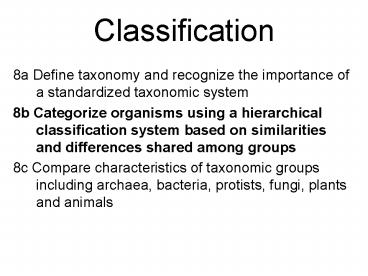Classification - PowerPoint PPT Presentation
Title:
Classification
Description:
Classification 8a Define taxonomy and recognize the importance of a standardized taxonomic system 8b Categorize organisms using a hierarchical classification system ... – PowerPoint PPT presentation
Number of Views:138
Avg rating:3.0/5.0
Title: Classification
1
Classification
- 8a Define taxonomy and recognize the importance
of a standardized taxonomic system - 8b Categorize organisms using a hierarchical
classification system based on similarities and
differences shared among groups - 8c Compare characteristics of taxonomic groups
including archaea, bacteria, protists, fungi,
plants and animals
2
Whats my name?
- Mountain lion
- Cougar
- Puma
- Panther
- Catamount
3
Taxonomy
- the naming, describing, and classifying organisms
based on characteristics
4
Carolus Linnaeus
- Father of taxonomy
5
Binomial Nomenclature
- formal system of naming organisms by giving each
a name composed of two parts, both of which use
Latin
6
Scientific Names
- The first word is the organisms Genus (closely
related species) - The second word is the organisms species
- Genus species
7
Homo sapiens
8
Felis concolor
9
Liquidambar styraciflua
10
Canis lupus
11
Flowchart
Linnaeuss System of Classification General to
Specific
Section 18-1
Kingdom
Phylum
Class
Order
Family
Genus
Species
12
(No Transcript)
13
(No Transcript)
14
Why classify?
- To group organisms according to similarities
- To name organisms in a way that all scientists
across the world can communicate (to get around
language barriers)
15
But scientific names can change
- With new discoveries, we can re-classify
organisms - Chinese tallow tree changed from Sapium
sebiferum toTriadica sebifera
16
Modern Evolutionary Classification
- The old Linnaeus way of using visible physical
similarities puts organisms that are very
different in the same groups. - So, now organisms are grouped according to
characteristics that show common ancestry. - Phylogeny the study of evolutionary
relationships among organisms. - All members of a genus share a recent common
ancestor.
17
Example Barnacles and Limpets
18
Traditional Classification Versus Cladogram pg.
452
Appendages
Conical Shells
Crustaceans
Gastropod
Crab
Crab
Limpet
Limpet
Barnacle
Barnacle
Molted exoskeleton
Segmentation
Tiny free-swimming larva
CLASSIFICATION BASED ON VISIBLE SIMILARITIES
CLADOGRAM
19
Example Barnacles and Limpets
- Adult barnacles look and act like limpets.
- Limpets have similar insides to a snail and dont
shed their shells like a snail mollusks. - Barnacles have similar anatomy and development to
crabs crustaceans. - So, barnacles are grouped with crabs and limpets
are grouped with snails.
20
(No Transcript)
21
Cladogram
- diagram that shows the evolutionary relationships
among organisms
22
- The closer together in a relational line the
organisms are, the more closely they are related
(the more recent their common ancestor) - The more similar the DNA the more recently they
shared a common ancestor and the more closely
they are related.
23
Derived Character
- trait that is shared by organisms with a recent
common ancestor
24
Clade
- Group consisting of its ancestor and all its
descendants
25
(No Transcript)
26
Cladogram of Six Kingdoms and Three Domains, pg.
460
DOMAIN ARCHAEA
DOMAIN EUKARYA
Kingdoms
Eubacteria Archaebacteria Protista Plantae Fungi A
nimalia
DOMAIN BACTERIA
27
http//ccl.northwestern.edu/simevolution/obonu/cla
dograms/Open-This-File.swf
28
Figure 3
- ___ Egg shells
- ___ Cells
- ___ Mammary glands
- ___ Feathers
- ___ Lungs
- ___ Four limbs
D
A
F
E
C
B
29
Dichotomous Key
- Series of ordered steps you follow to ID an
organism - To use, you read both options, decide which
variation is best, and move on to the next step.
30
31
Review
- Prokaryote vs. Eukaryote
32
Review
- Unicelluar vs. Multicellular
33
Review
- Autotroph vs. Heterotroph
34
(No Transcript)
35
3 Domains
- Recently, new discoveries at the molecular level
of organisms have caused a new way to categorize
domains. - Eukarya protists, fungi, plants, and animals
- Bacteria same as eubacteria
- Archaea same as archaebacteria
36
The 6 Kingdoms
- Eubacteria normal bacteria (strep, E. coli)
- Archaebacteria bacteria that live in extreme
conditions and are usually anaerobic (hot
springs, black mud, etc.) - Protista most microorganisms (one or only few
cells) - Fungi mushrooms, yeasts, mold
- Plantae plants
- Animalia - animals
37
Eubacteria
- Common term bacteria
- Cell type prokaryote
- of cells unicellular
- Cell walls present with peptidoglycan
- Type of nutrition autotroph or heterotroph
38
Eubacteria
- Examples
- E. coli
- Streptococcus
39
Archaebacteria
- Common term none, this is a rare type of
organism that lives in extreme places like hot
springs - Cell type prokaryote
- of cells unicellular
- Cell walls present without peptidoglycan
- Type of nutrition autotroph or heterotroph
40
Archaebacteria
- Examples
- Halobacterum (loves salt)
- Thermoproteus (likes hot water)
41
Protista
- Common terms protists or single-celled
organisms - Cell type eukaryote
- of cells most unicellular some colonial
some multicellular - Cell walls some have cellulose cell walls and
chloroplasts - Type of nutrition autotroph or heterotroph
42
Protista
- Poorly classified group (basically, if an
organsisms doesnt fit anywhere else, they put it
here - Examples
- Amoeba
- Paramecium
- Algae
43
Fungi
- Common term fungus
- Cell type eukaryote
- of cells most multicellular some unicellular
- Cell walls present made of chitin
- Type of nutrition heterotroph
44
Fungi
- Examples
- Mushrooms
- Yeast
- Mold
45
Plantae
- Common term plant
- Cell type eukaryote
- of cells multicellular
- Cell walls present made of cellulose
chloroplasts present - Type of nutrition autotroph (use photosynthesis)
46
Plantae
- Examples
- Mosses
- Ferns
- Pine trees
- Flowering plants
- Grass
47
(No Transcript)
48
Animalia
- Common term animal
- Cell type eukaryote
- of cells multicellular
- Cell walls no cell wall or chloroplasts
- Type of nutrition heterotroph
49
Animalia
- Examples
- Sponge
- Insects
- Spiders
- Fish
- Birds
- Reptiles
- Mammals
50
(No Transcript)































